By Todd Barron @ FoodieCuisine.com
A couple of years ago I received a nice bonus and ordered a Cookshack FEC-100 BBQ Smokerwith some of the proceeds. My wife was nice enough to let me do this and we (yes, we) have never regretted the choice. The Cookshack FEC-100 is a commercial meat smoker that is intended for restaurants or BBQ competitions. You can use it for the home, but it’s overkill for most applications. Even with that, I love it and have used it at least monthly for the past two years. I have cooked for my immediate family, our extended family, various charities around town, and even for local restaurants (for their workers to consume, not to sell.)
After waiting for a month, I received the FEC-100 delivered via a freight truck. The unit, without wood in it, weighs 420 pounds and can’t easily be transported. Although it’s heavy, it’s built on wheels and is easy to move around in a small area. Whenever I cook with mine I wheel it from the garage into the driveway, and then back once complete. I learned very quickly not to leave it in the garage as it generates way too much smoke. I tried venting the smoke but don’t have a proper setup to really do it. That’s ok though as I bought an all-weather cover that allows me to smoke in the rain or snow.
Here is the outside of the FEC-100, with the cover pushed back. I cook with the cover on as it’s high-fiber count nylon and is built to be cooked with while on the unit. The FEC-100 is highly insulated and never gets more than warm to the touch. Do NOT do this with other cookers as they will burn the covers and catch on fire.
Here is the smoker with the door open. I only have two racks in it in this shot. The fire pot at the bottom is where the wood chips pour into (and are ignited.) It generates the heat and the smoker can cook at up to 500 degrees. The foil lined plate is there to prevent fat from dripping into the fire pot. The entire unit is encased in stainless steel with a fire resistant insulation. Cookshack’s description of the construction is “double-walled 16-gauge stainless steel interior, 18-gauge stainless steel exterior 850ºF Spin-Glas Board ® insulation””.
Here is the control unit on the left side. It has a 20 pound wood hopper and a computer control system. You can set the temperature of the smoker, the time to cook, and the temperature to hold at once the time has expired. The panel shows you how much time is left and the current temp as well.
Here is a closer view of the hopper. For this run I used Applewood. You can buy pellets from various woods such as mesquite, hickory, oak, cherry, etc. I buy my wood from Pellet Grill Outlet as they have proven to be the cheapest with the best quality. The only thing you have to watch out for are wood pellets not made for smokers. You do NOT want to use the ones made for heating stoves as they contain chemicals that are not safe for cooking. PGO sells 60 lbs. of pellets for $60 that includes free shipping.
Here is the unit with the two 15 pound briskets loaded. I have a drip pan set below them and you can see the fire pot running. The unit will hold 100 lbs of pork, or 80 lbs of brisket, or 60 lbs of ribs at one time.
Here is a close up of the control unit and the temp probe. In Probe mode you can set how hot you want the probe to reach and the unit will switch to hold mode once the temp is reached. In this run I told the unit to cook at 226 until the probe reached 194 and then to hold at 140. Food can hold at 140 degrees safely forever (according to the FDA.) Eventually it will dry out, but bacteria cannot grow at 140. This is the key that allows you to put your meat in, set the unit, and walk away or go to sleep. No matter what you end up doing, when you come back it will be good to go.
Here is a closeup of the fire pot. Wood from the hopper is ground through an auger that is controlled by the computer. If the unit detects the temp is too low in the smoker, it grinds more wood and feeds it through. This allows the smoker to only use the exact amount of wood as necessary and also keeps the temp within 5 degrees of the target. This is key if you want to guarantee your results in BBQing.
Here is the probe inserted into the thickest part of one of the briskets. I set the unit to cook at 226 until the probe reaches 194.
The briskets after being in over night. I put them in at 4pm Saturday and this was taken around noon on Sunday. The probe was at 192 degrees when I removed them to sauce and foil.
Here is one of the briskets removed and with my homemade sauce put on it. You can see the sky reflecting in the sauce since I do this outdoors. After saucing the brisket, I cover it with foil, and put back in the smoker for a few hours. If you don’t like wet BBQ you can always skip this step. Sometimes I cook without a sauce, other times I do, it’s really just a matter of personal preference.
Here are the briskets after being sauced and wrapped. I put them back in and closed the door for a few hours. No probe is necessary as I’m steaming the meat at this point.
And finally, one of the briskets with the point removed and sliced. It was VERY tasty. 🙂
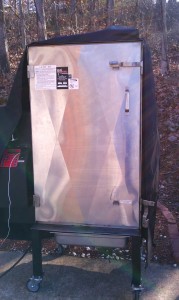
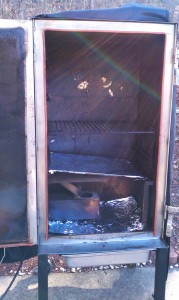
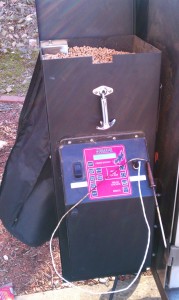
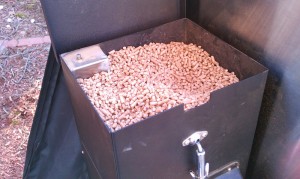
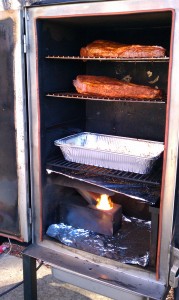
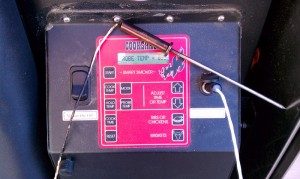
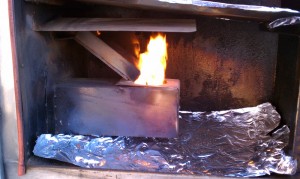
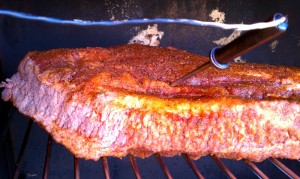
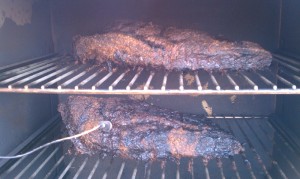
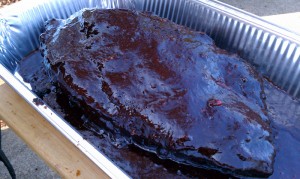
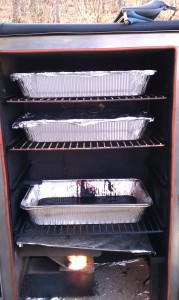
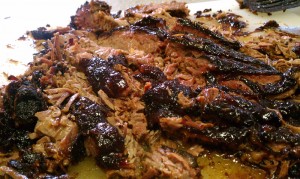

Interesting article. I was wondering if you ever put meat on the lowet tray (where you show your drip pan), and, if so, does it cook int a considerably shorter time frame as the upper two shelves?
Have you ever measured the tempature difference of the four shelves? I ask that because of the exhaust being placed mid-way in the smoker.
Good smoking!
Hi Steve,
I have put temp sensors on each rack and found them to range within 5 degrees F of each other. The top rack is the hotest, going down from there. If you want to shorten the cooking time, do not use a drip pan and put the meat on the top rack.
The drip pan does lower the temp of the above racks by about 5 degrees F as well. Either you can compensate by increasing the cooknig temp or the cooking time. Either way works just as well. I personally use a drip pan because it saves a ton of cleaning time.